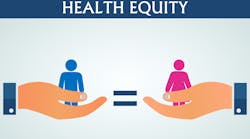The connection between oral health and overall well-being remains a persistent, untreated, and unaddressed issue in the United States. The CDC suggests that more 50% of Americans over the age of 30 have some degree of gum disease,1 which can have links to cancer, heart disease, stroke, diabetes, and other health issues.
While health-care organizations alone cannot control all the factors that contribute to poor oral health, they can make oral care more accessible and transparent by leveraging tools that are available in today’s digital marketplace. What’s more, they can meet the growing customer preference for these types of tools.
According to Statista, 88% of customers expect companies to have an online self-service portal.2 They want to manage their benefits 24/7 from any device, and when they run into a question, they want the tools and information at their fingertips to help them address it.
Oral health care and health equity are inextricably linked. Beyond just customer satisfaction and convenience, digital tools represent an important step toward fostering health equity by streamlining tedious, administrative back-end tasks and in turn, improving the quality of care throughout a patient’s journey.
You might also be interested in
New data: Americans are still not getting the dental care they need
4 areas where digital tools help advance oral health equity
1. Help patients understand the connection between their oral health and overall well being
Digital tools give members a better care experience. They make things more accessible and information more transparent so that patients understand the implications their oral health has on overall health. The functions of the mouth are often taken for granted, yet the ability to speak, smile, taste, and chew are important contributing factors toward quality of life and depend on the health of the teeth, gums, and mouth. At a minimum, dentistry and oral health need to be considered a part of medicine and overall health to facilitate optimum care and help close the equity gap.
Portals and mobile apps help foster this by establishing strong connections with patients through messaging tools, which can be used to send reminders and promote appointments and the continuation of care. They help supply oral health education materials as well as materials that address specific health concerns. This makes information more accessible and provides everyone with resources and assistance to achieve successful outcomes.
2. Enable a better member care experience
Portals and mobile apps can improve access to care by removing many of the common barriers to care. For instance, tools in multiple languages enable patients to find a provider and present information at the appointment, allowing for more equitable access. Portals and mobile apps offer capabilities to find providers through proximity and ratings, enhancing the member experience by directing patients to providers who can deliver the most appropriate, effective, and efficient care.
3. Empower dental practices with data-driven analytics and insights
Digital technologies significantly contribute to enhancing oral health equity by highlighting performance improvements in relevant areas. According to Harvard Public Health, lowering the barriers to access relevant data helps identify health disparities and craft actionable strategies to address them.3 Data-driven market analysis, provider analysis, benefit plan analysis, and reimbursement analysis empowers the dental industry to address oral health inequalities efficiently, which ensures resources are allocated where needed and treatment outcomes are measured effectively.
Combining insights from data analysis with member-facing digital solutions, such as find-a-provider tools, creates actional steps toward closing the health equity gap. This is done by using data-driven insights to automatically direct patients to high-performing providers, which enhances the patient experience while rewarding deserving providers.
4. Streamline workflows within dental practices
Incorporating digital tools into dental practices helps streamline operations by eliminating cumbersome manual workflows. Automating burdensome administrative tasks frees up valuable staff time, reduces the risk of errors, and enhances efficiency by minimizing duplication of services across entry points. For instance, real-time eligibility automatically checks that coverage is active and features real-time treatment plan reviews, claim processing, and immediate EOBs. This enables practices to provide complete cost transparency and collect exact patient balances at the time of service.
By automating repetitive tasks, dental practices can optimize resource allocation, which enables them to provide a higher standard of care to a broader patient base. Transitioning to digital processes equates to cost savings, allowing dental practices to redirect resources to improve access to care and other crucial areas, such as philanthropic efforts and targeted oral health equity initiatives.
The future of digital tools is now
The preference for self-service is part of a growing user experience trend that has become as important to buying decisions and customer loyalty as the products and services being offered. With digital tools here to stay, it’s important to recognize the long-term benefits that go beyond the immediate scope of convenience.
There is a great deal of work that needs to be done to create the systemic links and inner collaboration to include dental health in the general health-care conversation. With technology more accessible than ever, the digital era can bring improvements in linking dental care and overall health while directly affecting areas contributing to oral health equity.
Technology shapes patient perceptions, and having digital self-service is a winning proposition for dental providers and their members, payers, groups, and brokers. Dental benefit portals such as Skygen’s member portal enable patients to get answers and manage tasks and transactions with speed, efficiency, and convenience.
Digital tools can increase member satisfaction, lead to expanded relationships, and transform operations to digital workflows and real-time transactions, increasing efficiency and significantly reducing costs. The digital transformation to automation platforms and flexible strategies helps ensure everyone has the opportunity and ability to access quality dental care.
Larry Paul, DDS, is the chief dental officer for Skygen, overseeing all aspects of the company’s dental utilization review and management activities. He’s the clinical face of the company with a focus on using technology to empower population health-based efforts. He uses his clinical expertise to understand the member and provider experiences to ensure the best possible outcomes. Dr. Paul serves on several boards, including the board of visitors for his dental school alma mater, Temple University Kornberg School of Dentistry.
Editor's note: This article appeared in the November 2023 print edition of Dental Economics magazine. Dentists in North America are eligible for a complimentary print subscription. Sign up here.
References
- Gum disease. Centers for Disease Control and Prevention. Last reviewed November 18, 2020. https://www.cdc.gov/oralhealth/fast-facts/gum-disease/index.html
- Do you expect a brand or organization to have an online self-service support portal? 2023. https://www.statista.com/statistics/810374/share-of-customers-by-if-they-expect-brands-to-have-a-self-service-portal/
- Gonzalez JC. Health data is fragmented and biased. Here’s how we clean it up. Harvard Public Health. June 13, 2023. https://harvardpublichealth.org/health-policy-management/data-democratization-is-a-must-for-better-public-health-outcomes/







